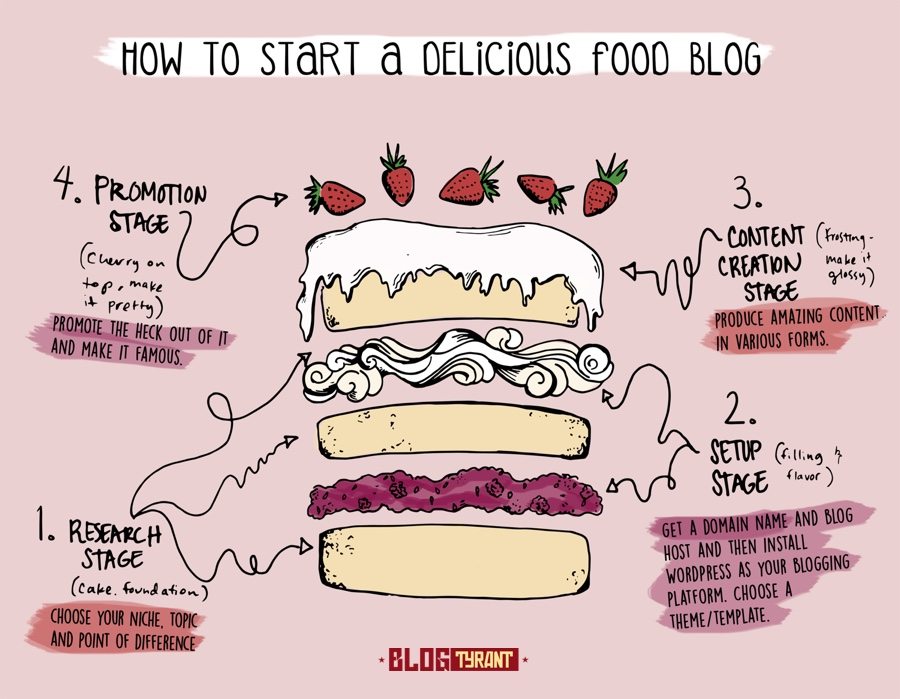
Want to learn how to start a food blog? I might be able to help with that.
You see, every now and then a new niche comes along and absolutely dominates the internet. Each one is slightly different, but over time you start to notice the common strategies and ideas that work for each one equally.
At the moment food blogging is massive.
That means there is an enormous opportunity to be successful but, in actual fact, it’s also an incredible chance to change the world for the better.
This is a big one so get a cuppa and warm up your scrolling finger!
NOTE: This post contains a few affiliate links. If you purchase something by clicking through to one of my partners I earn a small commission at no extra cost to you. In fact, it usually saves you money! Thanks for the support.
Overview of how to start a food blog
If you’re just looking for the broad strokes here’s one way to do it:
- Research stage – choose your niche, topic and point of difference.
- Setup stage – get a domain name and blog host and then install WordPress as your blogging platform. Choose a theme/template.
- Content creation stage – produce amazing content in various forms.
- Promotion stage – promote the heck out of it and make it famous.
- Bonus world-changing stage – This is where we look at how a simple blog can make a big difference.
I’m going to give a rough overview of all of these stages in the hope that it encourages you to do further research and really make a solid plan for your new food blog.
1. Research stage: choosing a topic for your food blog
When you are thinking about starting a food blog you really want to know your topic intimately.
As blogging becomes more and more popular, it’s a lot less likely that you will see much success with “general topic” blogs that focus on a lot of different things.
What seems to be doing well are blogs that have a unique niche angle.
Even better is when you mix that unique angle with a personal story and journey. That is when you start to get into solid branding territory.
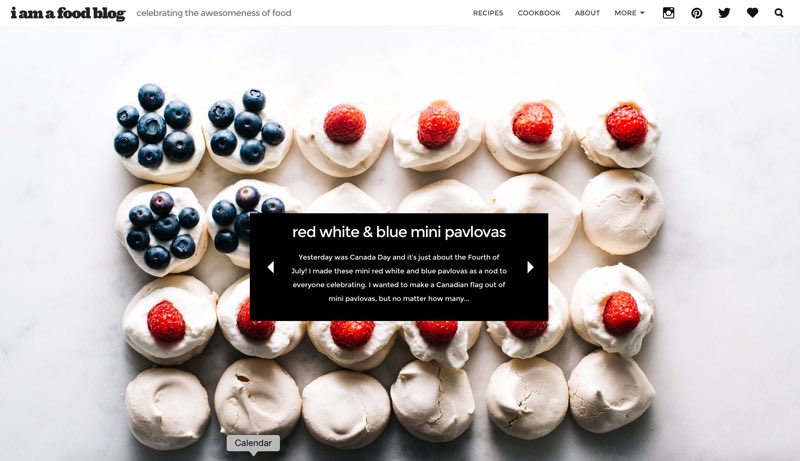
One of my favorite examples is I am a Food Blog by the very talented and funny Steph. Everything she does is infused with her own personality and taste and, as a reader, it’s very hard not to delve further into the blog if not to just look at her beautiful photographs and see what other crazy concoctions she’s come up with!
The main thing you want to ask yourself at this stage is: how can I be different from the rest?
Think about things like:
- What do I love about food?
- What are my strengths and weaknesses?
- What blogs inspire me and how can I be better/different from them?
- How can I help my target audience?
- What is the end-goal of this blog?
Before you start thinking about making money or anything like that, you really need to be solid on your own topic and branding. These types of questions will really make your long-term blogging progress much smoother because you’ll have guideposts to keep referring back to.
Remember, you don’t have to be fully planned out in order to get started. Some rough goals and ideas are enough at this stage. I spoke to my good friend Jen (on the right) from The Food Curators about getting started:
The initial idea came about when we were in Thailand, googling our hearts out for amazing cafes and restaurants. We are big travelers, and have specific taste when it comes to food and coffee (it has to be epic). We started compiling lists and images of the wonderful places we’d been to, to save for our friends and family (who are ALWAYS asking us for our travel tips). From there, we thought we could share it online as a collection of our foodie adventures, recipes and favorite places. It’s very personal to our lives and tastes.
Initially we started with just an Instagram feed, and once we looked into it, we set up a WordPress based blog. We purchased a domain, used a free template and asked a friend to install it for us. Without much experience in website setup, we fumbled our way through this process, delayed it a couple of times due to indecision and asked our contacts for advice. Once we started posting, we felt a little more confident about how we wanted it all to look and feel, and the sort of content we wanted to produce.
Since then though, we’ve invested a little more into the design, template and overall aesthetic of the blog. We’re kind of obsessed with it. It becomes more refined all the time, and the only way to get better at something is to just do it.”
Sure, it would be nice to have an entire business plan, marketing budgets, and branding ready to go but, usually, business doesn’t work like that. Sometimes it’s important to get started and learn on the run.
Spend a whole day visiting as many successful food blogs as you can and try to think about what makes them interesting or different. Keep a list of the ones close to your own topic and come up with ways you can be better, different and more comprehensive.
2. Setup stage: hosting and publishing your food blog
Once you’ve decided on what you’re going to write about you then need to actually set up your blog.
This is the stage where a lot of new bloggers feel a bit overwhelmed and get stuck. It’s a bit of a steep learning curve but, in all honesty, the setup process is actually pretty simple.
Every good, professional blog needs three elements:
- A unique domain name
This is the .com or .net thing that people type in their browsers in order to find your blog. - A reliable web host
This is where all of your files, content, images, etc. are stored. When people type in your domain name it looks up your server and shows them your blog. Here’s some FAQs about hosting and what it involves. - A blogging platform like WordPress
This is the thing you login to in order to write your posts, upload images, etc. Once you’ve purchased your domain name and web host you can install WordPress for free with just a few clicks.
A lot of aspiring pro-bloggers get stuck at this stage because they don’t want to pay the fees associated with getting their own host. Here’s a quick video elaborating:
There are a lot of free options out there for new bloggers but I always recommend that people avoid them because when your blog starts to grow you really need full ownership and control over that asset. With a free blog there is a good chance you don’t own it, can’t sell it, and often don’t have access to the back-end.
These things are essential.
I recommend BlueHost (affiliate link) as a good starting option for new bloggers. You get free domain name registration for a year and a discounted rate for being a Blog Tyrant reader.
Once you’ve purchased your domain name and web host you then need to select a WordPress theme that suits your needs.
It’s important to remember not to dwell on this stage too long because you can always change your theme and tinker with how it looks. Don’t let this part prevent you from getting setup.
When choosing a theme there are a few options available to you:
- Get a free theme
One of the advantages of an open source platform like WordPress is that there are literally tens of thousands of free themes to choose from. Some of them are awful, some are great. Just go to your WordPress dashboard and click Appearance > Themes and then start browsing through the demos. - Pay for a premium theme
Premium themes are those designed by experts to serve a particular purpose. They are usually visually more appealing and come with a variety of functions. I think Theme Forest (affiliate link) is a good place to start looking. - Create a new theme
If you want to make sure that your blog looks completely original you can pay to have someone design and build it for you. This is usually an expensive option and can take weeks or months to complete. I recommend only doing this when your first blog is making money and is ready for a more professional touch.
When selecting a theme you really need to think about how you are going to be using it and what you want readers to think and feel when they visit. This means taking into account things like colors, typography, photo areas, blog readability, ability to edit logos, etc.
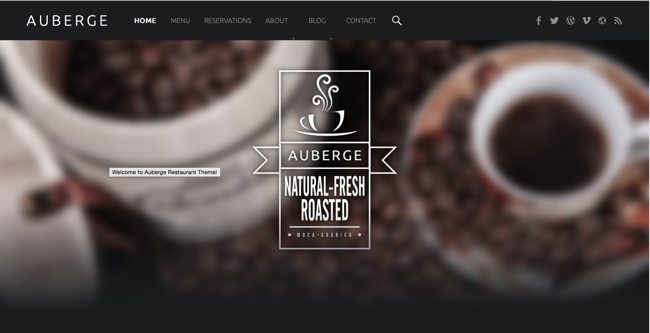
The Auberge theme is a good example of a beautiful free template designed specifically for food blogs. It has a heavy emphasis on photography but also allows for things like recipes and blog posts centered around food. And having been downloaded over 40,000 times you can be assured that it works.
That being said, you might not want to use a theme that has been downloaded 40,000 times and instead opt for something more unique. Yes, that is a legitimate concern, but you also have to remember that when you change the logo, colors and add your own photographs it is going to start to look a lot different.
3. Content creation stage: producing amazing stuff
Without a doubt, the most important part of any blog is the content.
And that content can and should take on many different forms – written posts, photographs, graphics, quotes, tools, videos, podcasts, etc.
Of course you don’t start off doing all of that at once, but rather gradually start to add and expand as you get bigger and want to tap into readers who consume your brand in different ways.
Start at the end and work backwards
One of the best tips I can give you is to start with the end result and work backwards.
What that means is that you come up with a rough plan for your blog in terms of what product you are going to promote or where you’d like to see it in a year’s time. You then work backwards and create very specific content that helps you get you to that position. Most bloggers do the opposite – they make content and then wonder what product or end-result to insert later. It’s messy.
Here’s an article about blogging strategy that can give you a full picture of how you can develop a plan like this in a few simple steps.
Make your own stuff
Another really important thing to do is try to make as much original stuff as you can.
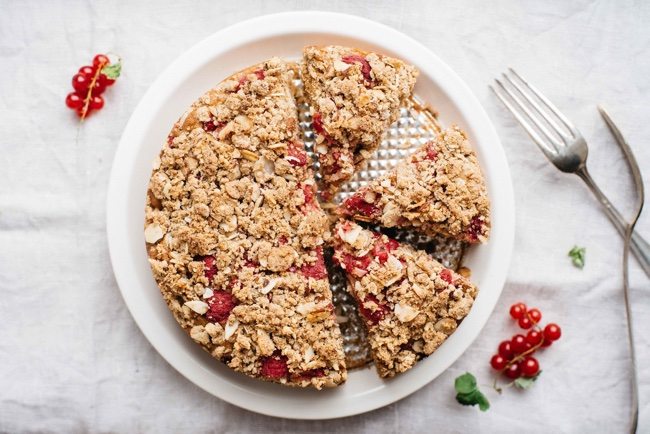
For example, if you look at a successful blog like Dolly and Oatmeal you’ll see that the recipes and photos as all done by Lindsey herself. There’s no stock footage – it’s all lovingly created from scratch.
Google loves this kind of effort, and so do readers. Here’s a bit more about blog images and best practices that might be useful for this.
Remember that unique angle?
When we were talking about deciding on your blog’s topic we spoke of the importance of a unique angle. Actually, it’s here in the content creation stage that it becomes most important.
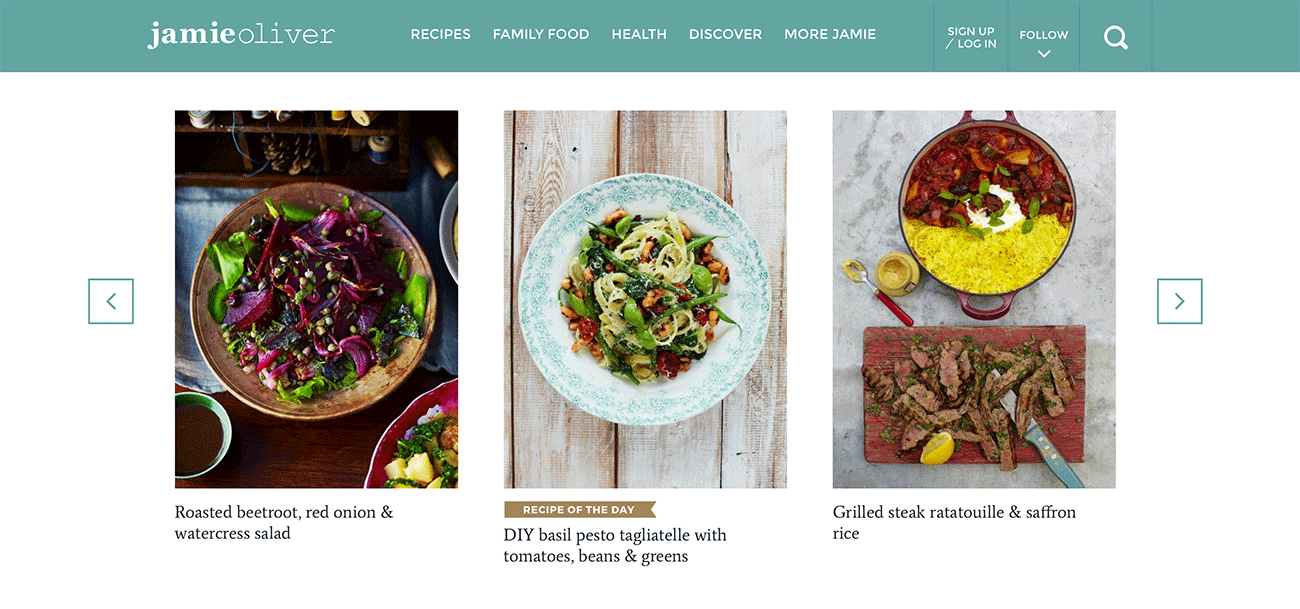
Do you remember when Jamie Oliver first became famous with the Naked Chef TV series? He went from a local lad to international celebrity off the back of a new style of relaxed, messy, unpretentious cooking. He literally changed the way food is cooked around the world (and olive oil sales!). But it all happened due to a personal brand that was different to the usual stuck up, old-fashioned cooking. He has a pretty handy website and foundation, by the way.
You don’t have to be original with your blog, but it’s important to find a way to be memorable. Try and make sure that everything you do from your logos to your content to your emails all fits in to one branded message.
Focus on a free giveaway and valuable mailing list
Giving something away for free is still a really powerful way to grow a business online. The best part? It’s is relatively inexpensive to set up and works in almost any niche. The more email subscribers you have the better your blog will do in the long term.
The idea here is that you create a free eBook or course and then offer it as a “bribe” for people when they sign up to your mailing list. The course or eBook then gets delivered automatically when they sign up, and you start building a mailing list that you can use to promote future blog posts and products to.
Try to have a valuable and highly relevant giveaway relevant ready on your blog as soon as it goes live and start collecting email subscribers. That list will be very important.
4. Promotion stage: finding the right audience
When it comes to a successful food blog you essentially have three ways to find traffic, customers and a long term readership:
- Google traffic
Getting traffic from Google is a fantastic way to grow a business. It is, however, extremely hard to find for most new bloggers due to the intense competition. It takes time to build, but you can pay to use their ads program. - Social networking sites
Sites like Pinterest, Instagram, Facebook and Twitter can be really huge for blogs – especially if you have a lot of nice photos or content that is easy to digest and share. Again, there is advertising programs for all of these. - Traditional media
A lot of bloggers discount traditional media as being expensive and out of date, but it actually works really well. A feature in a magazine or newspaper will still send you an immense amount of traffic, and can totally transform things for your blog.
So how do we actually go about getting traffic from these sources?
Let’s take a look.
Getting optimized for Google search traffic
Firstly, you want to make sure that your blog is SEO optimized by following Google’s best practices. This is a huge topic so I recommend that you follow this guide to getting traffic from Google and keeping up with the major SEO updates and what Google is looking for.
It’s important to note here that you shouldn’t get too obsessed with SEO. A lot of bloggers devote too much time to this and as a result don’t produce enough good content. But that is what Google wants to see. Most of the time, if you focus on strong, unique, and helpful content you will tick 80% of the SEO boxes along the way.
We should also remember that relying on Google traffic can be dangerous. There’s no guarantee that they will keep you at those top ranking positions and, if you drop off, your business could be in trouble.
Figure out which social networking sites suit you
Make sure you remember this: you should not be on every social networking site.
Think about it – we have Twitter, Facebook, Google+, Pinterest, Instagram, Snapchat, Vine… the list is endless. The thing is, if you focus on being active and prolific on all of these sites you won’t ever have time to focus on creating content and growing your business in a more sustainable way.
So what do you do?
This comes down to a mixture of research and testing. Spend a day looking at the biggest 20-30 blogs in your niche and have a look at which social networking sites seem to work best for them. Don’t just focus on followers (those can be faked) but look at how engaged the audience is, how many times things get shared, and how it causes interaction on the blog itself.
Then set yourself up on these and start testing for yourself. The results are always going to be different depending on the brand and target audience, but over time you will start noticing which one hits the spot and you’ll be able to focus on it and get more detailed with targeting, ads, campaigns, competitions, etc.
Getting offline to promote your online presence
One example of this that I’ve seen in the food blogging world is The Food Curators (again) – I regularly see Mel and Jen on buses around town.
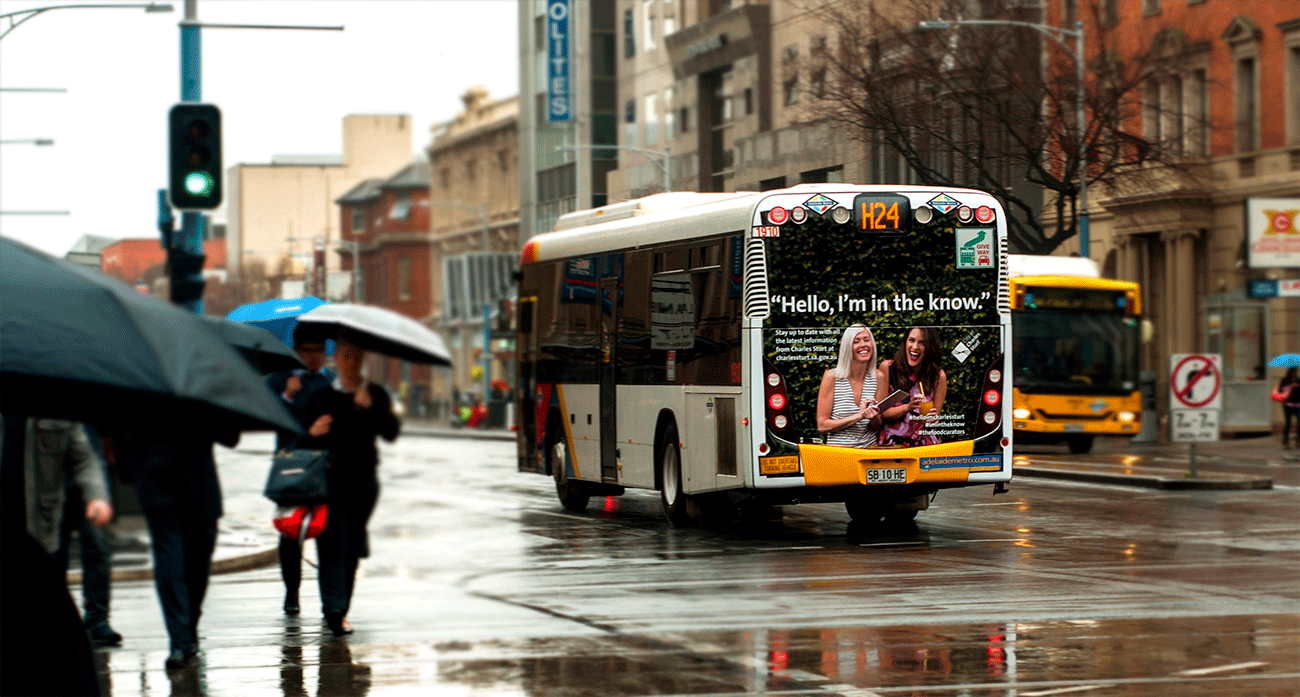
They’ve also manged to team up with local supermarkets in the past, which is a really clever way of making sure their blog gets seen by an audience who might otherwise have never encountered the website. It’s a great mix of online and offline promotion.
There are so many other things you can do in the offline world. For example, if you visit local restaurants or stores to review them, make sure you give them your business card and then email them when you positive review goes up. That’s gold for a cafe, and they’ll usually share it with their social networking pages. Free promo.
It’s also good to remember that a good old expensive publicist can do wonders to help you launch a business. An article in a traditional newspaper about your exciting new food blog can really jump start a career.
You just need an angle.
5. Bonus stage: change the world with your food blog
We talk about making content useful and helpful a lot here on Blog Tyrant, and with a food blog you have an actual opportunity to change the world for the better.
With a population of almost 7.5 billion people, food has now become a major issue for our world. Especially as we battle with healthcare and climate change issues, the way we produce and think about food has become more important than ever.
And it really comes down to one thing: meat.
Recent studies have shown that reducing meat consumption is one of the most important things we can do for a planet that is struggling with greenhouse gas emissions, water shortages, and healthcare costs.
Animals bred for meat have an incredibly harmful carbon footprint. They need to be fed (and that food needs to be grown and watered and shipped), watered, shipped, killed, refrigerated, trucked to stores, stocked in stores, etc. Adding to this is the fact that the methane gas produced by livestock during their lifespan causes major damage.
Food bloggers can be incredibly influential when it comes to encouraging people to eat less meat each week, or at least sourcing their food from local, ethical producers. Whether you care about climate change or not is one thing, but I think everyone agrees that factory farming and live exports are awfully brutal practices that we should give up.
Blogging can help to bring about these changes.
So, if you start a food blog, I encourage you to write about these topics.
Create more exciting vegetarian recipes, promote ethical and vego restaurants, and show people that there are good alternatives to a super heavy meat diet. Nobody wants to read an aggressive and preachy vegan blog though – so make these issues fun and approachable and gentle.
I don’t think anyone is going to change a long held belief by reading a blog post, but helping to spread awareness might plant a few important seeds.
Any advice for someone starting a food blog?
I’d really love to know whether you think I’ve missed any key points for people who might be starting a food blog soon. A lot of blogging niches overlap, so I’d love to hear whether you have any tips for a newcomer who might be trawling through the comments for advice. Please leave a comment with any feedback, or anything at all that might be useful.
How to Start a Food Blog and Change the World originally posted at Blog Tyrant
No comments:
Post a Comment